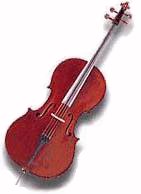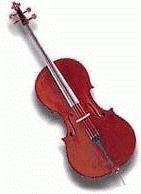 | The Violoncelloedited by webmaster, May 1998 |  |
 | The Violoncelloedited by webmaster, May 1998 |  |
The name "violoncello" (or cello for short) first became current in the mid-17th century, but bass violins of one kind or another are mentioned in several literary works of even earlier centuries.
The cello actually originated in the early 16th century as a member of the violin family. The earliest violins were an amalgam of the features of well-known instruments in common use about 1500: the rebec, the renaissance fiddle and the lira da braccio. It is now well known that the viols were actually not ancestors of the violins in any decisive aspect of construction, tuning or playing technique. Agricola, writing in 1529, describes instruments of the early violin family with different ranges, including a bass instrument with three strings tuned F-C-G (with F being the lower string, then ascending in fifths). H. Gerle, writing in 1532, describes an instrument with the same tuning as our modern cello, C-G-D-A, in ascending order. An instrument turned a whole note lower (Bflat-F-C-G) continued popular in England and France into the 18th century.
The earliest known makers of instruments that would be recognized today as cellos were Andrea Amati (who died before 1580) of Cremona, Gasparo da Salo (1540-1609) of Brescia and his pupil Giovanni Paolo Maggini (1581-1632). Their cellos were larger than modern cellos (up to 80 cm in length), and survivers have been shortened.
One famous cello made by Amati, is called "The King." The violoncello has paintings of the arms, devices and mottoes of Charles IX, the king of France. Because of its decorations it is believed to be one of the thirty-eight violoncellos ordered for Charles IX. On the center of the back can be seen the crown over the remaining outline of the coat of arms. The physical characteristics of this violoncello are not much different from the modern day violoncello. This allows us to conclude that violoncellos have not changed much since then. (Cowling, The Cello, pg. 28)
The move toward a smaller cello took place in Bologna in the 1600's when silver-wound lower strings were invented. It should be noted here that many luthiers were making cellos before the famous Stradivari appeared on the scene. However, it was Stradivari who decided around the year 1707 to go with a length of about 75 cm, and this became the standard. It is also of interest that the necks of the entire violin family of instruments were lengthened during the 18th century. It was also in the early 18th century that cello makers experiment with five string cellos. Some think that Bach may have had the five string cello in mind for his 6th Cello Suite.
The many parts of the violoncello can be divided into three categories. First, are the exterior parts, second, are the interior parts, and third, the fittings. There are more fittings than any other group of parts.
The first exterior part is the top, the table, the belly or plate. It is constructed of two pieces of pine or spruce. It is graded in thickness from 3/16 of an inch to 9/64 of an inch. Next, are the sides of the violoncello which are also called ribs. They are six pieces of maple glued to the top and back of the violoncello. They stretch on each side one from the top to the waist, one on the waist and one from the waist to the bottom. The purfling is a triple line of dyed wood along the outer edge of the top and back of the violoncello. The purfling fits into a groove and serves two purposes. It prevents cracking of the wood and it is also decorative. The button is another exterior part. It strengthens the joint between the neck and the back and is sometimes outlined in ebony. There are holes on each side of the violoncello top on the waist (middle). These holes allow sound to escape from the interior of the violoncello. They are called F holes. This is because the shape of the hole looks like the letter F. (Cowling, The Cello, p. 18-19)
The Second category of parts are the fittings, or the objects that are placed on the outside of the violoncello. First is the bridge which is made of maple and is not glued but held down by the strings. It is set between the notches of the F holes and has notches on the top of it for the strings. It is custom fitted for the particular violoncello it is going to be placed on so that it fits the contour of the top. The tailpiece is made of ebony, and the lower ends of the strings are attached to it. The tailpiece is held in place by the tail gut which wraps around the plug and attaches to the bottom of the tailpiece. The plug is inserted into a hole at the bottom of the violoncello. The plug serves as a place to insert the end pin and to wrap the tail gut. The end pin is inserted into the plug and its length is adjustable. The end pin rests on the floor and holds the violoncello up for the player. Some end pins are removable and some slide into the violoncello. The neck, peg box and scroll are on the top of the violoncello, they are made from one piece of wood. The finger board is made of ebony and is glued to the neck and provides a surface on which to press the strings with your fingers to vary their length and change the note. The pegs are made of ebony or rosewood and are fitted into the peg box. The strings are wrapped around the pegs and turning the peg can either raise or lower the pitch of the string. The nut is made of ebony and glued to the top of the finger board. It has notches in it for the strings and spaces the strings evenly. The four strings are C, the lowest, G, D, and A, the highest. The earlier cellos, the same as the other instruments of the violin family, had gut strings. Most cellists now use either steel strings, or nylon wound with aluminum or silver. Some still prefer all gut strings.
The third category of violoncello parts is the interior. The lining is twelve strips of pine that are glued to the edge of the sides and provide a surface on which to glue the top and back. The sound post is a small cylindrical piece of spruce or pine that fits between the top and back without glue. It is in front of the left foot of the bridge and its function is to transfer sound from the top to the back. (Cowling, The Cello, p. 20-21)
For two hundred years the Amati family made some of the finest violoncellos in the world. Andrea Amati's sons were as follows: Antonio (1540-?), and Girolamo I (1561-1630) who sired Nicolo (1596-1684) who sired Girolamo II (1649-1740). The sons of Andrea Amati, used the designs made by their father. The two of them worked together and labeled their violoncellos jointly, possibly even after Antonio's death. Nicolo was the best instrument maker of the Amati family. He also taught some of the other great masters of instrument making. Some of Nicolo's students became famous makers on their own. They were his son Girolamo II, Antonio Stradivari, Andrea Guarneri and G. B. Rogeri. (Cowling, The Cello, page 34)
Antonio Stradivari was the greatest maker of violoncellos and violins. He lived from 1644 to 1737. The knowledge that he was a student of Nicolo Amati comes from a label in a violin that he says he is a pupil of Nicolo. (Cowling, The Cello, page 34)
In conclusion, the violoncello is an instrument with a very interesting and large background. The majority of cellos today are mass produced in factories. However, there are still many individuals making wonderful cellos by hand, just as was done by Amati, Stradivari, and the other old master makers. Advancing cello students usually try to buy one of these fine hand-made cellos as they become more proficient, and need a better sounding instrument.
Baines, Anthony. Musical Instruments Through The Ages. New York: Walker and Company, 1961. Bragrad, Professor Roger, and Doctor DeHen Ferdinard. Musical Instruments In Art and History. New York: The Viking Press, 1967 (translated: 1968). Cowling, Elizabeth. The Cello. Great Britain: Scribners, 1975. Gammond, Peter. Classical Music. New York: Harmony Books, 1988. Sachs, Curt. History of Musical Instruments. New York: W.W.Norton and Co., 1940. Schwartz, Harry W. The Story of Musical Instruments. New York: Doubleday, Doran and Company Inc., 1939. "Cello", Groliers Electronic Encyclopedia, C.S., Grolier Electronic Publishing Inc., 1993. "Cello", World Book Multimedia Encyclopedia, C.S., World Book Inc., 1995. Stringed Instruments, Groliers Electronic Encyclopedia, C.S., Grolier Electronic Publishing Inc., 1993. "Viol", Groliers Electronic Encyclopedia,C.S., Grolier Electronic Publishing, Inc., 1993. "Violoncello". The New Grove Dictionary of Music and Musicians, Vol. 19, 1980, pgs. 856-862. The Violin Family. The New Grove Series, 1989, W.W. Norton and Company.
![[Picture]](ics4.gif) |
Direct correspondence to the appropriate ICS
Staff Webmaster: Webmaster Director: John Michel Copyright � 1995-97 Internet Cello Society |
|---|